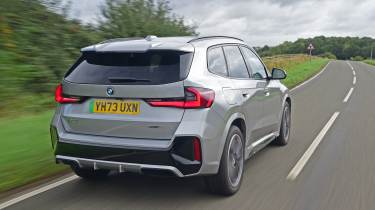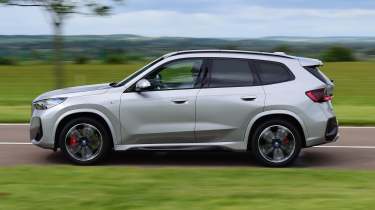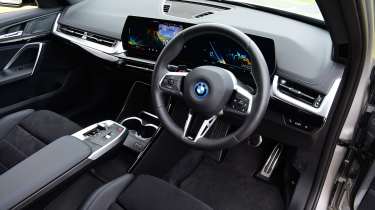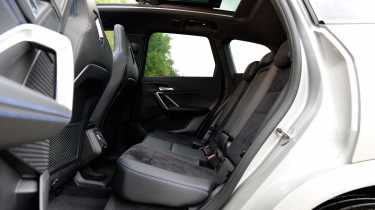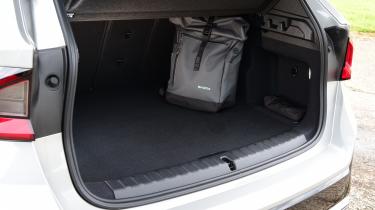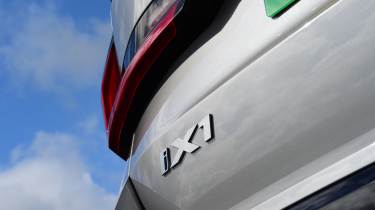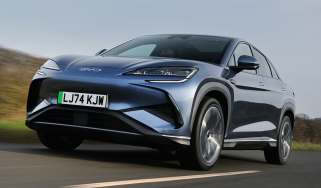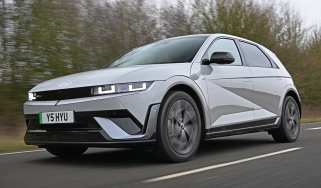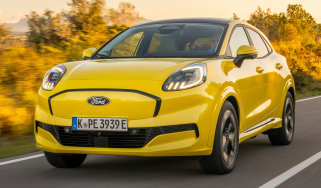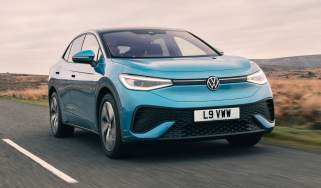BMW iX1 review – an upmarket electric family SUV
“The iX1 is the electric version of the BMW X1 SUV, so it has many of the same qualities: it’s good to drive and feels upmarket”
Pros
- Fast
- Roomy
- Feels familiar
Cons
- Weight ruins driving experience
- Not as versatile as petrol X1
- Middling range figures
Verdict – is the BMW iX1 a good car?
As the EV counterpart to the X1, the BMW iX1 is a great first electric car for someone already familiar with that model. It’s fast like we’ve come to expect from EVs, and it’s still a roomy car despite sitting below the iX3 and iX5 in the brand’s lineup. There are some caveats, though – while the iX1 is good to drive, it’s not quite as good as the standard X1 in this department because of the extra weight of its battery, and other electric SUVs boast a longer range.
BMW iX1 models, specs and alternatives
Many modern electric cars are designed from the start to use batteries only, but the BMW iX1 is not one of them. It’s closely related to the petrol and diesel-powered BMW X1 SUV and has been modified to accept batteries and electric motors. This is good and bad – it means there are some compromises, but it also looks a lot like a normal car inside and out, making it an easy transition for buyers who are unlikely to have owned an EV before.
So along with the BMW X1’s petrol, diesel and plug-in hybrid engines, there is now the BMW iX1’s fully-electric set-up. Being a small premium SUV, the iX1 has lots of rivals including the Volvo EX40 (and the EC40 coupe-SUV), Mercedes EQA, Lexus UX 300e, Audi Q4 e-tron and Tesla Model Y. All of these are aimed at people who want an upmarket SUV but don’t need something large and imposing like one of BMW’s more expensive models.
Like with many of the brand’s cars, the iX1 differentiates itself from the competition by being more enjoyable to drive. It’s more satisfying in corners than the Model Y, XC40 or the EQA and has plenty of performance to enjoy as well. It’s not as good to drive as any of the combustion-powered X1 models, though, because the iX1 is very heavy. Weight is rarely desirable in cars because it means stiffer, more uncomfortable suspension has to be fitted to control the mass, among other things.
The BMW iX1 launched as a dual-motor model with four-wheel drive and a 67kWh battery, badged the xDrive30. This enables a range of 270 miles according to official numbers, although in a recent test against the Volvo EC40 we achieved a real-world figure of 201 miles (the EC40 achieved 194 miles despite claiming 300 miles).
While these xDrive models produce lots of grip, they aren’t cheap: the four-wheel drive iX1 costs more than £54,000, almost £20,000 more than the entry-level X1. BMW later introduced a more affordable eDrive20 version of the iX1 with a greater focus on efficiency and improved range. This model can manage up to 288 miles to a charge and costs from just over £46,000. It’s a welcome addition to the lineup, with most buyers probably more concerned with range figures than outright performance – with 201bhp, it’s still more powerful than the petrol or diesel X1.
|
Trim levels |
Power options |
|
|
BMW iX1 alternatives
Premium small electric SUVs
Hybrid SUVs
- Range Rover Evoque PHEV
- BMW X1 PHEV
- Volvo XC40 PHEV
Petrol SUVs
- BMW X1 xDrive23i
- Audi Q3 35 TFSI
- Mercedes GLA 200
Range, charging & running costs
From launch, the BMW iX1’s 67kWh battery enabled a maximum driving range of between 259 and 270 miles, but the brand introduced an eDrive20 model with an improved official range of up to 288 miles from late 2023. This higher figure puts the eDrive20 on par with the entry-level Volvo EX40 – higher spec variants are still able to travel much further than the iX1. The BMW’s range should be plenty for most people, but long-distance drivers might be better served by the Kia EV6 or Skoda Enyaq. The Tesla Model Y Long Range RWD has a 373-mile range figure.
During our head-to-head testing of the eDrive20 and Model Y, both cars averaged 3.7 miles/kWh.
The 130kW charging capability is on a par with the likes of the Enyaq and the Volkswagen ID.4, albeit a bit short of the figures achievable on the EV6 or Hyundai Ioniq 5. A top-up from 10-80% charge takes just under half an hour, while a home wallbox will fully charge the battery overnight.
|
Model |
Battery size |
Range |
|
iX1 xDrive30 iX1 eDrive20 |
67kWh 67kWh |
259-270 miles 287-288 miles |
Electric motor, drive & performance
The dual-motor, four-wheel-drive powertrain (xDrive30) that’s available is potent. Its 309bhp is more than you get in the performance-led Volkswagen ID.4 GTX; consequently, the iX1 is very quick from a standing start. The sprint from 0-62mph takes just 5.6 seconds, and there’s even a boost function that provides full power for a limited time. Unlike some electric cars, you don’t get the sense that the iX1 is running out of puff at motorway speeds.
The eDrive20 joined the range later with a single front-mounted motor and greater focus on efficiency at the cost of some performance. It still produces 201bhp, which should be enough for most drivers, and will do 0-62mph in 8.6 seconds up to an electronically-limited 106mph. Though it’s perfectly capable on a twisty road, it’s not as fun as the more potent four-wheel drive model. We did, however, find the xDrive20’s handling and refinement a step above that of the Tesla Model Y.
If you’d like to hide the zero-emission powertrain from your friends and family, there is the option of a synthesised engine note. It’s meant to sound like a six-cylinder engine and sort of does, but it feels a little forced and unnecessary. Turn it off and you’re aware that the iX1 is very refined; you can’t even hear the electric motor that’s just in front of you. Like numerous electric cars, the quietness does amplify the wind rush around the wing mirrors at higher speeds, but this isn’t too disturbing.
As touched on above, the iX1 is more engaging to drive than its nearest competitors. But drive the iX1 after a petrol-powered X1 and you’ll come away disappointed by the EV. The iX1 is significantly heavier, and its responsiveness is blunted as a result. BMW hasn’t managed to hide the extra weight, and has fitted a firmer suspension setup to cope. It may have adaptive suspension as standard, but the ride is notchy and sometimes a little crashy.
|
Model |
Power |
0-62mph |
Top speed |
|
iX1 xDrive30 iX1 eDrive20 |
309bhp 201bhp |
5.6s 8.6s |
111mph 106mph |
Interior & comfort
The BMW X1 might be the brand’s entry-level SUV, but it doesn’t come across like that inside. Luxurious materials and an impressive build quality go some way to backing up the iX1’s price. Just forget that the standard (less expensive) X1 gets the same high-spec cabin. The dashboard features two large screens – one for driving information and one for infotainment – and these come as standard.
Following the introduction of the eDrive20 model, the iX1 is now available in three trim levels: Sport, xLine and M Sport. Standard equipment includes the BMW Maps navigation system, dual-zone climate control, plus plenty of driver assistance and safety kit including parking assist and a reversing camera.
xLine gives a rugged, off-road-esque appearance while M Sport is sportier, as the name suggests. Both models get heated front seats, while M Sport adds a racier look and some additional features like wireless phone charging and extended LED lighting.
| Key features |
| |
|
Sport
|
xLine (Sport plus...)
|
M Sport (xLine plus…)
|
Practicality & boot space
BMW’s X1 badge suggests that this car will be cramped inside, because it’s seemingly the smallest BMW SUV. That’s actually the coupe-inspired BMW X2; the X1 is surprisingly roomy inside. There’s plenty of space for four large adults and enough space between the seats that kids might not be able to kick your seatbacks.
It’s a shame that the rear seats don’t slide fore and aft like they do in the petrol and diesel versions, while the iX1 has a transmission tunnel that robs space from the middle-seat passenger. Cars designed from the outset to be electric-only don’t tend to have this tunnel, so something like a Hyundai Ioniq 5 might be more spacious if every seat is going to be occupied on a regular basis. Make sure you and your passengers are happy with the slightly raised floor in the rear, too.
|
Size comparison | |||
|
Model |
Length |
Width |
Height |
|
BMW iX1 |
4,500mm |
1,845mm |
1,616mm |
|
Volvo EC40 |
4,440mm |
1,910mm |
1,591mm |
|
Mercedes EQA |
4,463mm |
1,834mm |
1,615mm |
|
Lexus UX 300e |
4,495mm |
1,840mm |
1,545mm |
Boot space
The 490-litre boot is a perfectly decent size. It’s a whole 150 litres more than the space you get in a Mercedes EQA, and more than some cars from the next size up (such as the Nissan Ariya and Toyota bZ4X). There’s a cable storage area under the boot floor, which is handy as long as you haven’t made full use of the cargo capacity.
|
Boot space comparison | |
|
Model |
Boot space |
|
BMW iX1 |
490 litres |
|
Volvo EC40 |
413 litres |
|
Mercedes EQA |
340 litres |
|
Lexus UX 300e |
367 litres |
Reliability & safety
The diesel BMW X1 was tested by safety organisation Euro NCAP in 2022 and was awarded a full five-star score – with impressive ratings of more than 75% in each of the four categories: adult occupant protection (86%), child occupant protection (89%), vulnerable road users (76%) and safety assist (92%). This assessment also applies to the electric iX1.
BMW as a brand finished in 14th place out of 32 brands in our 2024 Driver Power customer satisfaction survey, comfortably beating rivals Mercedes (25th) and Audi (27th) and significantly improving on its 21st-place finish the year before. Owners love the brand’s powertrains, ride and handling and infotainment tech. In terms of reliability, 21.4% of BMW owners reported an issue with their car in the first year, which is slightly fewer than average.
Which Is Best?
Cheapest
- Name150kW eDrive20 Sport 65kWh 5dr Auto
- Gearbox typeAuto
- RRP£42,355
Most Economical
- Name150kW eDrive20 Sport 65kWh 5dr Auto [22kWCh]
- Gearbox typeAuto
- RRP£43,235
Fastest
- Name230kW xDrive30 xLine 65kWh 5dr Auto
- Gearbox typeAuto
- RRP£48,865
